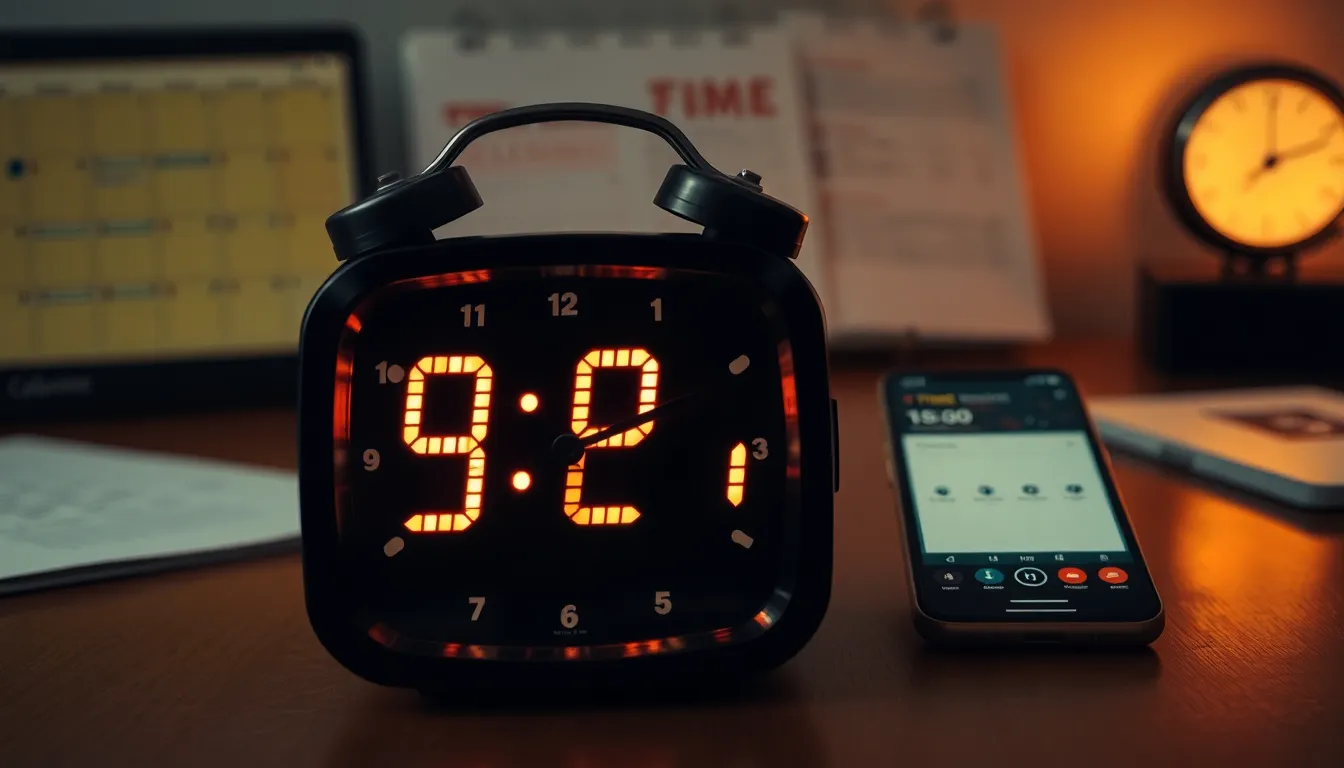Table of Contents
ToggleEver found yourself in a time crunch, wondering what time it was just 53 minutes ago? You’re not alone. Time can be a slippery little rascal, and sometimes it feels like it’s playing hide and seek. Whether you’re late for a meeting or trying to figure out if you can still grab that last slice of pizza, knowing the time from a short while back can save the day.
In this fast-paced world, every minute counts. So, let’s unravel the mystery of those 53 minutes. With a bit of math and a sprinkle of humor, he’ll break it down for you. Get ready to impress your friends with your newfound time-telling prowess and maybe even earn a few laughs along the way. After all, who knew time could be this entertaining?
Understanding Time Calculations
Time calculations provide essential skills for daily life. Knowing how to determine what time was a specific duration ago, like 53 minutes, enhances time management abilities.
Importance of Time Calculation
Calculating time accurately influences scheduling and punctuality. Committing to precise time awareness leads to improved productivity and better planning. In professional settings, timely arrivals affect perceptions of reliability. Socially, understanding time reinforces commitments to family and friends. Mastering time calculations fosters confidence, enabling individuals to manage their day effectively.
Everyday Scenarios
Common situations arise where time calculations prove useful. For instance, remembering a meeting time requires accurate subtraction of minutes. In other cases, someone may need to track when they last ate to plan meals. Waiting for a ride often necessitates knowing how long ago the friend left. Routines like workout sessions become easier to manage with clear time calculations. Many people face instances where quick time adjustments enhance both personal and professional interactions.
How to Calculate Time

Calculating time accurately can enhance daily routines. It simplifies many aspects of life and aids in effective time management.
Simple Subtraction Method
Subtracting minutes from the current time represents a straightforward approach to finding past times. Start by noting the current hour and minute. For example, if the current time is 3:00 PM, subtracting 53 minutes requires manipulating both the hour and minute hand. Break the minutes down to 3 minutes to reach the full hour, leaving 50 minutes. This results in 2:07 PM. Understanding how to perform these calculations provides essential skills.
Using Digital Clocks
Digital clocks make time calculations more accessible and intuitive. Most digital clocks display minutes and seconds clearly, allowing for easy adjustments. To determine the time 53 minutes ago, look at the current time displayed. Suppose it’s 6:45 PM; subtracting 53 minutes means subtracting from both the hour and minutes appropriately. Adjusting the hour, you’ll find it’s now 5:52 PM. Utilizing a digital clock speeds up calculations and reduces confusion in daily tasks.
Tools and Resources
Calculating time can be made easier with various tools and resources available today. These options enhance accuracy and simplify the process of determining what time it was 53 minutes ago.
Online Time Calculators
Numerous online time calculators exist to assist with time calculations. Users can input the current time and easily subtract minutes, providing immediate results. Many of these calculators also allow users to specify different time zones, which can be essential for planning across varying locations. For anyone needing quick and precise calculations, these online tools offer user-friendly interfaces and instant responses.
Smartphone Applications
Several smartphone applications enhance time management skills significantly. Many of these apps not only allow users to calculate past times but also help in scheduling future events. Popular apps in this domain include time-tracking tools and calendar applications that integrate time calculations. Users access these apps easily, enabling quick adjustments and seamless planning. Popular options like Google Calendar and Clock provide functionalities that simplify understanding past and future times effectively.
Real-World Applications
Understanding what time it was 53 minutes ago proves beneficial in various aspects of daily life. Recognizing how to apply this knowledge enhances time management significantly.
Scheduling and Planning
Effective scheduling relies heavily on accurate time calculations. Knowing what time it was 53 minutes ago can help with punctuality in meetings and appointments. Adjusting one’s schedule requires an awareness of previous commitments. For instance, planning a dinner based on current time rather than visual approximation involves precise calculations. Counting backwards in real-time builds a stronger grasp of time management. Businesses often benefit from improved scheduling, allowing teams to meet deadlines without stress.
Historical Context
Time awareness has evolved alongside civilization. In earlier societies, understanding time often centered on natural indicators like the sun and moon. Historical records show that people relied on such markers to organize tasks. Antique tools for measuring time, like sundials, originated from this necessity. Over time, mechanical clocks revolutionized how individuals perceive and manage their days. Rapid advancements in technology today offer accurate time readings and calculations. Society’s journey emphasizes the significance of precise timekeeping throughout history.
Mastering the ability to calculate what time it was 53 minutes ago is more than just a fun exercise. It’s a valuable skill that enhances everyday life. With improved time management, individuals can navigate their schedules more effectively and maintain punctuality in both personal and professional settings.
Utilizing tools like digital clocks and time calculator apps simplifies the process, making it accessible for everyone. As people become more adept at understanding time, they’ll find themselves better equipped to handle commitments and enjoy a more organized lifestyle. Embracing these skills not only boosts productivity but also fosters a greater appreciation for the significance of time in daily activities.










